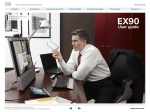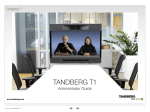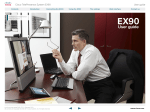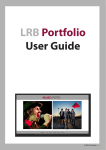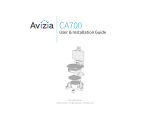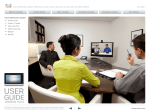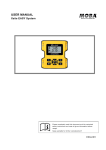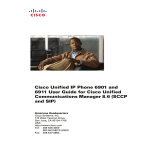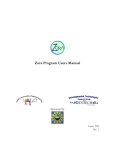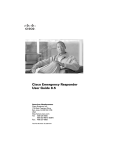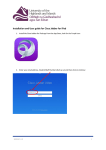Download Cisco TelePresence System EX60 and EX90 User Guide (TC7.3)
Transcript
1 Cisco TelePresence EX60 and EX90 TC 7.3 User Guide D1501611 User Guide Cisco TelePresence EX60 and EX90 Produced: December 2014 for TC7.3 All contents © 2010–2014 Cisco Systems, Inc. All rights reserved. 2 Contents What’s in this guide Introduction to Video Conferencing Best Practice......................................................................... 4 Tour the touch screen........................................................... 5 Log Onto a System with Your Own Credentials.................... 6 Video Calls Place Call From Contact List................................................. 8 Edit a Contact List Entry, then Place the Call........................ 9 Place Call Using Name.........................................................10 Place Call Using IP Address.................................................11 Place Call Using Number......................................................12 Receive Call..........................................................................13 Receive Call While in Another Call.......................................14 Transfer.................................................................................15 Consult and Transfer............................................................16 Disconnect Yourself From Call.............................................17 Put Call on Hold and Resume a Call on Hold.......................18 Shared lines..........................................................................19 Change Call Rate................................................................. 20 Enable Do Not Disturb..........................................................21 Enable Standby.................................................................... 22 View Keypad While in a Call................................................ 23 Add Additional Participants to Existing Call......................... 24 Add Incoming Call to Existing Call....................................... 25 View Meeting Participant List.............................................. 26 Manage Conference Call Layout......................................... 27 Lock Speaker....................................................................... 28 Disconnect Participant from Call......................................... 29 Share Content Start and Stop Presentation.................................................31 Share a Physical Document................................................. 32 Change Presentation Layout............................................... 33 Scheduled Meetings View Meeting List................................................................ 35 Join Scheduled Meeting...................................................... 36 Parallel Meetings................................................................. 37 Contacts Directory.............................................................................. 39 Recents............................................................................... 40 Favorites...............................................................................41 Add Someone to Favorites, While in a Call......................... 42 Camera View Camera Settings......................................................... 44 Manage Selfview................................................................. 45 Resize the Selfview PiP....................................................... 46 Move the Selfview PiP......................................................... 47 Control the Camera of the Other Participant....................... 48 Connections and Settings Connect the EX60............................................................... 50 Connect the EX90................................................................51 Gain Access to the Settings................................................ 52 Setting the Background Image............................................ 53 Ringtone & Sound................................................................ 54 Bluetooth............................................................................. 55 Camera Control................................................................... 56 Display................................................................................. 57 Select Language................................................................. 58 System Information.............................................................. 59 Call Status........................................................................... 60 Diagnostic Mode...................................................................61 Restart System.................................................................... 62 Administrator....................................................................... 63 Administrator Settings—Set Date and Time......................... 64 Administrator Settings—Call Details..................................... 65 Administrator Settings—Provisioning Wizard....................... 66 Administrator Settings—Multipoint Mode............................. 67 Administrator Settings—IP & VLAN...................................... 68 Administrator Settings—Network Status Codec.................. 69 Administrator Settings—Network Status Touch................... 70 Administrator Settings—SIP..................................................71 Administrator Settings—H323.............................................. 72 Administrator Settings—EMC Resilience Mode.................... 73 Administrator Settings—Factory Reset..................................74 All entries in the table of contents are clickable hyperlinks that will take you to the corresponding article. To go between chapters, you may also click on any of the icons in the sidebar. Note! Some of the features described in this user guide are optional and they may therefore not be present on your system. D1501611 User Guide Cisco TelePresence EX60 and EX90 Produced: December 2014 for TC7.3 All contents © 2010–2014 Cisco Systems, Inc. All rights reserved. 3 i Introduction to Video Conferencing D1501611 User Guide Cisco TelePresence EX60 and EX90 Produced: December 2014 for TC7.3 All contents © 2010–2014 Cisco Systems, Inc. All rights reserved. 4 Introduction to Video Conferencing Best Practice Other Tips Brightness control A successful video conference provides a face-to-face meeting, even if the participants are miles or continents apart. Keep in mind that it still is a meeting— normal etiquette and dress code apply even here. General •Consider setting the unit to Automatic Answer, but mute the microphone for privacy reasons, if possible. •Do not forget to rehearse “the noble art of operating a video system” to the extent needed. In the meeting room •Make sure that you do not experience obstacles blocking the view to the microphone at all times. •Noise sources like computers placed on the table should always be placed away from the microphone of your unit. The noise from such sources is often perceived as surprisingly loud by the remote participants. • Pay attention to the background your system will provide to the remote participants. If the camera captures the corridor outside your office, people passing by may distract your remote participants. This applies as well to curtains with a distinct texture pattern and, in particular, to curtains moving due to draught in the room. group of presenters. Smaller systems may force you to choose between showing the presentation or the presenter. •For duo video some attention is needed. To adjust brightness, colors or other settings of your system, use the touch pad. Adjust the monitor to suit the conditions of the conference room. Duo video is sometimes shown side–by– side with half the screen showing the presentation and the other half showing the presenter. Provide the impression that you seem to look towards the presentation instead of the impression that you sit with your back towards it, when all is viewed on the remote monitor. If in doubt, look straight into the camera to avoid this situation. •If you are going to share content you will normally make use of duo video. That implies the use of two video streams, one showing the presentation and the other showing the presenter—or the D1501611 User Guide Cisco TelePresence EX60 and EX90 Produced: December 2014 for TC7.3 All contents © 2010–2014 Cisco Systems, Inc. All rights reserved. 5 Introduction to Video Conferencing Tour the touch screen Tap the upper left corner to activate / deactivate the Do not disturb feature, to activate /deactivate the Standby feature, and to access the Settings. Tap the ? to contact or access the Help desk, if available. Operating tips Tap the Camera icon to activate self-view and camera settings. Tap the Headphones icon to select between loudspeaker and headphones. Time of day is indicated in the upper right corner. Tap to mute / unmute microphone. Note that some of the features shown here are optional and may not show up on your system. Tap the touch screen to wake up the system, if needed. Adjust volume here (tap and drag). Any messages to you while you were away will be indicated here. Tap Dial to invoke the dial pad. Tap Contacts to invoke the list of contacts including Favorites, Directory and Recents. Tap Meetings to invoke a list of upcoming scheduled meetings. Tap Messages to invoke the voice mail system, if applicable. When set to Do Not Disturb, ringtones are muted and call attempts made by others to reach you will appear as missed calls. You may, however, place calls as much as you like. As default, there is a 60 minutes timeout on the Do not disturb (after which the system will return to normal operation), but this may have been changed to a different setting by your Video Support Team. Tap a button to activate its function. Scroll in lists as outlined. D1501611 User Guide Cisco TelePresence EX60 and EX90 Produced: December 2014 for TC7.3 All contents © 2010–2014 Cisco Systems, Inc. All rights reserved. 6 Introduction to Video Conferencing Log Onto a System with Your Own Credentials Tap Sign In. Select your profile. About Hot-desking Input your credentials and tap Sign In. Video systems located in meeting rooms and quiet rooms and running under CUCM (Cisco Unified Communications Manager) may allow you to log in to the video system with your own personal credentials. CUCM will then route all incoming calls destined for you to that specific video system. The system will confirm a successful sign-in. You will now receive calls destined for you. To sign out tap Sign-out. You will be prompted to confirm your intentions. D1501611 User Guide Cisco TelePresence EX60 and EX90 Produced: December 2014 for TC7.3 All contents © 2010–2014 Cisco Systems, Inc. All rights reserved. 7 Video Calls D1501611 User Guide Cisco TelePresence EX60 and EX90 Produced: December 2014 for TC7.3 All contents © 2010–2014 Cisco Systems, Inc. All rights reserved. 8 Place Call About the Lists of Contacts Place Call From Contact List Your lists of Contacts consist of three parts: Favorites. These contacts have put there by you. These entries will typically be someone you call frequently or otherwise need to access in a swift and convenient manner from time to time. Tap Contacts. To search for someone in a specific list (Favorites, Directory or Recents), tap that list (a) and then scroll down (b) to locate the entry. Alternatively, tap the Search or Dial field to invoke the virtual keyboard. Directory will typically be a corporate directory installed on your system by your video support team. Recents is a list of calls you have placed, received or missed earlier. You may clear the Recents list for privacy reasons, see “Recents” on page 40. The following options apply: •You may key in a name, number or an IP address and the system will look in all lists for you. •You may tap a tab and then scroll through the list or key in a name or number. Your search will then be restricted to that specific list. Key in the name, number, or IP address. Matches will appear as you type. There is an extended numerical mode available, which also contains special characters. When you are ready to place the call, tap the green Call button. •You may add the entry to the list of Favorites; edit aspects of the entry before calling; change the call rate and remove the entry from Recents,. To toggle between the alphanumerical mode and the extended numerical mode tap the key in the lower left corner of the keyboard, as outlined. D1501611 User Guide Cisco TelePresence EX60 and EX90 Produced: December 2014 for TC7.3 All contents © 2010–2014 Cisco Systems, Inc. All rights reserved. 9 Place Call Edit a Contact List Entry, then Place the Call About Entry Edits You may have to edit an entry in one of the Contact lists before you place the call. There may be a need to add a prefix, a suffix or otherwise alter the entry to ensure success. Tap More ( ) to gain access to the options. Tap Edit & Call to invoke the virtual keyboard. Apply your editing and tap the green CALL button, to place the call. D1501611 User Guide Cisco TelePresence EX60 and EX90 Produced: December 2014 for TC7.3 All contents © 2010–2014 Cisco Systems, Inc. All rights reserved. 10 Place Call Place Call Using Name About Placing Calls You may call someone who is not listed in your list of contacts by keying in their name, address or number using the virtual keyboard of the Touch pad. Tap Dial to invoke the numerical dialpad. Tap Keyboard ) to invoke the ( virtual keyboard. Key in the name. Matches will appear as you type. Anyone you have previously called will appear in the Recents list (until you clear that list) and you may then transfer any of them to your list of Favorites. This is described in the section Contacts. Calling extensions. Sometimes you may be urged to enter numbers during a call, typically to reach extensions or to provide a pin code. Tap Keypad (this button appears as soon as the call is placed) to invoke the keypad needed for this. There is an extended numerical mode available, which also contains special characters. When you are ready to place the call, tap the green Call button. To toggle between the alphanumerical mode and the extended numerical mode tap the key in the lower left corner of the keyboard. D1501611 User Guide Cisco TelePresence EX60 and EX90 Produced: December 2014 for TC7.3 All contents © 2010–2014 Cisco Systems, Inc. All rights reserved. 11 Place Call Place Call Using IP Address About Placing Calls 192.198.100.1 Tap Dial to invoke the numerical dialpad. Type the IP address. Tap and hold to type the point sign used in IPaddresses. * When you are ready to place the call, tap the green Call button. You may call someone who is not listed in your list of contacts by keying in their name, address or number using the virtual keyboard of the Touch pad. Anyone you have previously called will appear in the Recents list (until you clear that list) and you may then transfer any of them to your list of Favorites. This is described in the section Contacts. Calling extensions. Sometimes you may be urged to enter numbers during a call, typically to reach extensions or to provide a pin code. Tap Keypad (this button appears as soon as the call is placed) to invoke the keypad needed for this. D1501611 User Guide Cisco TelePresence EX60 and EX90 Produced: December 2014 for TC7.3 All contents © 2010–2014 Cisco Systems, Inc. All rights reserved. 12 Place Call Place Call Using Number About Placing Calls You may call someone who is not listed in your list of contacts by keying in their name, address or number using the virtual keyboard of the Touch pad. Tap Dial to invoke the numerical dialpad. Type the number. When you are ready to place the call, tap the green Call button. Anyone you have previously called will appear in the Recents list (until you clear that list) and you may then transfer any of them to your list of Favorites. This is described in the section Contacts. Calling extensions. Sometimes you may be urged to enter numbers during a call, typically to reach extensions or to provide a pin code. Tap Keypad (this button appears as soon as the call is placed) to invoke the keypad needed for this. D1501611 User Guide Cisco TelePresence EX60 and EX90 Produced: December 2014 for TC7.3 All contents © 2010–2014 Cisco Systems, Inc. All rights reserved. 13 Receive Call Receive Call If Someone Calls You If you set up the system to respond to incoming calls automatically (Auto Answer) you may want to mute the system microphone(s), to preserve privacy. Microphone(s) are muted if this symbol is illuminated. To mute / unmute the microphone(s), tap the symbol. •If someone calls you, you may accept, decline or ignore the call. •If you decline the call, busy information will be sent to the calling party. •If you ignore the call, the calling party will perceive this as if you were absent (you did not pick up the call. •You may want to set your system to respond automatically to an incoming call (Auto Answer). This is described in “Administrator Settings—Call Details” on page 65. Observe that your video support team may have password protected this menu. •If you choose to activate Auto Answer you may want to mute the microphone to preserve privacy. This must be set up manually every time. D1501611 User Guide Cisco TelePresence EX60 and EX90 Produced: December 2014 for TC7.3 All contents © 2010–2014 Cisco Systems, Inc. All rights reserved. 14 Receive Call Receive Call While in Another Call The identity of the new incoming call. About the Options Decline the incoming call and carry on as you have been doing. Add: If your system is equipped with the MultiSite option you may merge the incoming call with the existing. If you already are in a call, you may accept another incoming call under certain circumstances. For systems without MultiSite installed, the incoming call may still be merged, but as an audio-only call (not shown). Accept the incoming call, while holding the current call or group of calls. Accept the incoming call, while ending the current call or group of calls. D1501611 User Guide Cisco TelePresence EX60 and EX90 Produced: December 2014 for TC7.3 All contents © 2010–2014 Cisco Systems, Inc. All rights reserved. 15 Transfer Call Transfer About Transfer Basically, you have two options when transferring calls; viz. unattended and consultative transfer. In a call tap Transfer. Tap Complete transfer—see also text in side bar. Locate whom to call in the usual way. Place the call in the usual way. The scenario described on this page is the unattended transfer, where you transfer the call to someone else without consulting that person before the transfer is carried out. If you consult the person first, you will transfer after having used the swap feature—see the next page for more on this. The call will be transferred. D1501611 User Guide Cisco TelePresence EX60 and EX90 Produced: December 2014 for TC7.3 All contents © 2010–2014 Cisco Systems, Inc. All rights reserved. 16 Transfer Call Consult and Transfer About Consult and Transfer This feature allows you to be in a call with two parties, but one at a time only. You may swap whom you are in call with, and you may connect the two together, while you leave the call. Assume that you are in a call. Tap Hold. Tap + Place New Call, as outlined, or tap Resume to go back to the one you were in call with (to undo your action). Locate whom to call in the usual way. Place the call in the usual way. You are now in the new call while the one you were in call with still is on hold. Tap Swap to go between the two parties and Transfer to connect the two together, while you leave the call. D1501611 User Guide Cisco TelePresence EX60 and EX90 Produced: December 2014 for TC7.3 All contents © 2010–2014 Cisco Systems, Inc. All rights reserved. 17 End Call Disconnect Yourself From Call About Disconnecting Yourself Tapping End in a call will disconnect yourself from a call. In a call with two parties only, this will then terminate the call. In a conference call with multiple participants tapping End will terminate your participation only if you are a regular participant. However, if you are the host of such a conference, i.e. the one who initiated it, tapping End will cause the entire conference to terminate. To disconnect yourself from a call, tap End. D1501611 User Guide Cisco TelePresence EX60 and EX90 Produced: December 2014 for TC7.3 All contents © 2010–2014 Cisco Systems, Inc. All rights reserved. 18 Hold Put Call on Hold and Resume a Call on Hold Assume that you are in a call. Tap Hold. Tap Resume to go back to the one you were in call with (to undo your action). About Putting on Hold Putting someone on hold is typically something you do as an initial step when transferring someone to another person, but it may also be used when you need to consult a person or as an alternative to muting also including stopping the video transmission. D1501611 User Guide Cisco TelePresence EX60 and EX90 Produced: December 2014 for TC7.3 All contents © 2010–2014 Cisco Systems, Inc. All rights reserved. 19 Call center Shared lines If there is activity on the shared line, this will be indicated the orange field along the top of the display. About this feature Video systems used in call centers may be set up to share a common line so that anyone of those sharing a line may respond to an incoming call. If someone on the shared line has put herself on hold, you may pick that call up by tapping RESUME. If the current call has not been put on hold, you may barge in by tapping Barge. D1501611 User Guide Cisco TelePresence EX60 and EX90 Produced: December 2014 for TC7.3 All contents © 2010–2014 Cisco Systems, Inc. All rights reserved. 20 Call Rate Change Call Rate About Call Rate Call rate is the term used to express the amount of bandwidth allocated to the call and is measured in kbps (kilobits per second). This can be done before you call someone only. Tap More ( ) to gain access to the options. Tap Call Rate. Change the call rate by moving the slider. The higher the call rate is, the better the quality will be, but on the expense of higher bandwidth consumption. The system comes with a default call rate. This is set by your video support team as a part of the Administrator Settings (password protected). Why would you like to temporarily change this setting? In most cases you will use it to avoid choking the video call when you try to call someone at a higher rate than their system and connection support. Call rate cannot be changed during a call, but you may change it just before you place a call, as outlined here. D1501611 User Guide Cisco TelePresence EX60 and EX90 Produced: December 2014 for TC7.3 All contents © 2010–2014 Cisco Systems, Inc. All rights reserved. 21 Availability Enable Do Not Disturb About Do Not Disturb Your system can be set to not respond to incoming calls. You may, however, use it to call others as much as you want. Tap the field in the upper left corner. Tap Available or Do not Disturb. Tap anywhere outside the menu to exit the menu, putting changes into effect. D1501611 User Guide Cisco TelePresence EX60 and EX90 Produced: December 2014 for TC7.3 All contents © 2010–2014 Cisco Systems, Inc. All rights reserved. 22 Availability Enable Standby About Standby Your system can be set to Standby to save electrical energy. You will still be able to receive calls as usual. Tap the field in the upper left corner. Tap Standby. The screen will turn itself off after a few seconds. Tap the screen to wake it up. D1501611 User Guide Cisco TelePresence EX60 and EX90 Produced: December 2014 for TC7.3 All contents © 2010–2014 Cisco Systems, Inc. All rights reserved. 23 Add Extension Numbers and Pin Codes View Keypad While in a Call Using Keypad in a Call In a call you may get prompted to submit numbers to be able to reach an extension or otherwise gain entrance to something (for example by means of a PIN-code). To be able to submit this you will need to invoke the keypad on the touch screen. In a call, tap Keypad. D1501611 User Guide Cisco TelePresence EX60 and EX90 Produced: December 2014 for TC7.3 All contents © 2010–2014 Cisco Systems, Inc. All rights reserved. 24 Conference Calls with Multiple Participants Add Additional Participants to Existing Call About Video Conferences Your video system may be equipped with the capability to initiate a video conference with several participants. Assume that you already are in a call. This call may have been initiated by you or by someone else (someone have called you). Tap Add. Locate whom to call, in the usual way. The maximum number of participants supported by your video system will depend on system configuration and the video infrastructure. If in doubt, contact your video support team. If you want to initiate a video conference, you must call each participant one by one. If you are the one who initiated the conference initiated the conference you will be able to terminate the entire conference as well. The other participants, however, may only disconnect themselves from the conference. Place the call, in the usual way. You may alter the Call settings of that call before you place it—see side bar for more. You may be prompted to tap Merge to create the conference. This new call will now be added to the existing, thus creating a conference. You may cancel this call without terminating the first call you were in. Call settings. Those you call may have video systems with different bandwidths. You are not constrained to set all participants to a bandwidth that all systems support. The Call rate may be set individually for all participants in order to provide everyone with the best quality available for their system. See “Change Call Rate” on page 20. D1501611 User Guide Cisco TelePresence EX60 and EX90 Produced: December 2014 for TC7.3 This is an optional feature that may, or may not, be installed on your system. All contents © 2010–2014 Cisco Systems, Inc. All rights reserved. 25 Conference Calls with Multiple Participants About Adding Incoming Calls Add Incoming Call to Existing Call The identity of the new incoming call is stated here. Decline the incoming call and carry on as you have been doing. Add: Provided that your system supports it: Accept the incoming call and merge it with the ongoing call. Assume that you are already in a call. If you then receive another incoming call, you will have the following options: •You may decline the call and continue with what you were doing. Some systems may accept that you merge the incoming call with the existing, but as an audio-only call. •You may put the current call on You may be prompted to put the current call (or group of calls) on hold before merging can take place. to someone else, including the one you were talking to. hold and accept the new call. At any time you may swap between the two. •You may transfer the incoming call •You may, after putting the Accept the incoming call, while holding the current call or group of calls. Accept the incoming call, while ending the current call or group of calls. incoming call on hold, later decide to merge this call with the existing (optional feature). •You may merge the incoming call directly with the ongoing call (ACCEPT & MERGE). This applies to MultiSite equipped systems only. D1501611 User Guide Cisco TelePresence EX60 and EX90 Produced: December 2014 for TC7.3 All contents © 2010–2014 Cisco Systems, Inc. All rights reserved. 26 Conference Calls with Multiple Participants View Meeting Participant List Using Participant List This is a convenient way to obtain information about all the participants and their current status. In addition, you may use the list to disconnect participants from the conference or to grant them certain rights, such as to retain the position as prominent speaker even if someone else starts speaking. These features are outlined on the following pages. In a call, swipe your finger horizontally to the left... ...or tap the little dot not shown in white. The list will show all the participants, who is speaking for the time being, who is sharing content (if applicable), as well as who has been put on hold (if applicable). D1501611 User Guide Cisco TelePresence EX60 and EX90 Produced: December 2014 for TC7.3 All contents © 2010–2014 Cisco Systems, Inc. All rights reserved. 27 Conference Calls with Multiple Participants Manage Conference Call Layout To change the existing layout on your video screen, tap Layout. Tap the new preferred layout. About Layout Options The new layout will now be put in effect. You may alter the screen layout when you are in a call. The Touch pad will show the options available. The actual options may differ from what is shown here, but the Touch device will always show you what is available. The WYSIWYG (what you see is what you get) principle applies even here. Including a Selfview Selfview (what the others see from your video system) may be added to any layout in the usual way. To invoke the selfview See “Manage Selfview” on page 45. If needed, you may also move the selfview to a different location. See “Move the Selfview PiP” on page 47. D1501611 User Guide Cisco TelePresence EX60 and EX90 Produced: December 2014 for TC7.3 All contents © 2010–2014 Cisco Systems, Inc. All rights reserved. 28 Conference Calls with Multiple Participants Lock Speaker About Lock speaker This is an example of a layout with one of the participants shown as the prominent speaker, i.e. shown larger than the other(s). In a video conference with several participants the one who speaks will, as default, be shown as the large image (provided you haven’t set up the layout otherwise). This is referred to as voice switching. However, you may want to keep showing one of the participants as the prominent speaker, typically shown larger than the others. To make this happen activate the function Lock as speaker, as shown on this page. Start with a layout showing one the participants as the prominent speaker, and tap that speaker’s avatar. Tap Lock as speaker. Once activated the name of this field will change to Unlock as speaker. To unlock, repeat the process tapping Unlock as Speaker instead. D1501611 User Guide Cisco TelePresence EX60 and EX90 Produced: December 2014 for TC7.3 All contents © 2010–2014 Cisco Systems, Inc. All rights reserved. 29 Conference Calls with Multiple Participants Disconnect Participant from Call About Disconnect You may also invoke the list of participants and tap a participant in that list. Any participant entitled to it may disconnect any of the other participants. Tap the participant, either in the view as shown, or in the list of participants (see “View Meeting Participant List” on page 26). Then tap Drop. Tap the participant to be disconnected. You must be entitled to do so. Tap Drop to disconnect the selected participant. D1501611 User Guide Cisco TelePresence EX60 and EX90 Produced: December 2014 for TC7.3 All contents © 2010–2014 Cisco Systems, Inc. All rights reserved. 30 Share Content D1501611 User Guide Cisco TelePresence EX60 and EX90 Produced: December 2014 for TC7.3 All contents © 2010–2014 Cisco Systems, Inc. All rights reserved. 31 Share Content Start and Stop Presentation About Content Sharing Your video system may serve as your PC screen outside calls. In a call tap Preview PC to see the desktop. Your desktop will not be exposed to the other side. You will need to tap Share to actually expose your desktop. Tap Preview PC to preview the content in advance. Tap Share to actually start sharing the content. In a call you may view your PC screen without sharing it with the remote site(s). If the thumbnail image showing the other participants obstructs important parts of your PC-screen you may move it in the same way as you may with a PiP (see “Move the Selfview PiP” on page 47). More about using your video system as your PC screen can be found in “Connect the EX60” on page 50 and “Connect the EX90” on page 51. To stop the Presentation, tap Stop Sharing. D1501611 User Guide Cisco TelePresence EX60 and EX90 Produced: December 2014 for TC7.3 All contents © 2010–2014 Cisco Systems, Inc. All rights reserved. 32 Share Content Share a Physical Document Share Physical Objects The camera can be tilted as shown to enable you to share items on your physical desktop (we are not referring to the virtual desktop of your computer screen). The image will be flipped vertically to show it correctly to the other side. The camera can be tilted, if needed, to serve as a document camera. Image will be flipped vertically (turned upside down) to show it correctly to those you speak to (the other side). D1501611 User Guide Cisco TelePresence EX60 and EX90 Produced: December 2014 for TC7.3 All contents © 2010–2014 Cisco Systems, Inc. All rights reserved. 33 Share content Change Presentation Layout About Presentation Layout You may be able to change the layout of the screen during presentations. Typical options available will be with or without showing the presenter and showing the presenter as either a PiP (Picture in Picture) or PoP (Picture outside Picture). Tap Layout to invoke the layout options. The layout options available on your system may differ from those shown here, but the layouts shown are always those you may choose between. Select your preferred layout by tapping it. D1501611 User Guide Cisco TelePresence EX60 and EX90 Produced: December 2014 for TC7.3 All contents © 2010–2014 Cisco Systems, Inc. All rights reserved. 34 Your video system may be connected to a management system capable of scheduling video meetings for you. Any meetings scheduled will then appear in a List of Meetings on your Touch device. Scheduled Meetings D1501611 User Guide Cisco TelePresence EX60 and EX90 Produced: December 2014 for TC7.3 All contents © 2010–2014 Cisco Systems, Inc. All rights reserved. 35 Scheduled Meetings View Meeting List Meeting List Basics The meeting list will typically look like shown here. Tap an entry in the list to obtain more information about the meeting. Tap Meetings to invoke the list of meetings. Tap on the little expansion symbol, as outlined, to get even more information. Your video system may be connected to a management system capable of scheduling video meetings. Any meetings scheduled will then appear in a List of Meetings. The List of Meetings contains a list of upcoming, meetings scheduled to take place during the next 14 days (this setting may have been changed by your video support team). The list is sorted using grouping headers. The main grouping category is by day (e.g.: TODAY, TOMORROW, then WEDNESDAY, JUNE 20, 2014 etc). If you tap an item in the list then more information will become available. Tap again to collapse the information box. When a scheduled meeting appears as Private meeting it will contain information about the organizer only. There will be no title, no expandable meeting outline as well as no dial-in information. D1501611 User Guide Cisco TelePresence EX60 and EX90 Produced: December 2014 for TC7.3 All contents © 2010–2014 Cisco Systems, Inc. All rights reserved. 36 Scheduled Meetings Join Scheduled Meeting About Joining Although the default setting lets you join in up to 10 minutes in advance, your video support team may have implemented a different setting. If you tap a meeting in the list you will see more about the meeting. The start and end time of the scheduled meeting are given in the expanded meeting information. A scheduled meeting may connect you automatically, or you may have to tap Join Meeting. On your video system the Meeting Reminder will appear once it is possible to join a meeting. Exactly when that will be depends on the Start time buffer setting. Default buffer setting is 10 minutes, but your video support team may have changed this. It is not possible to join the meeting earlier than the setting dictates. The meeting reminder contains a time indicator stating when the meeting starts, or alternatively for how long the meeting has been going on (an ongoing meeting is referred to as a Meeting in progress). When the meeting starts you will be offered to join in, to postpone the offer to join in for 5 minutes, or to just dismiss the offer. The text Starting now will be shown during a time interval spanning from 30 seconds before to 30 seconds after the scheduled start time of the meeting. Extending an ongoing meeting Scheduled meetings have a fixed start and end time. You may want to extend an ongoing meeting. This will be accepted by the system if no other meeting is scheduled for any of the video systems involved, during the period of possible extension. If an extension is sustainable, the Meeting will end notification will include an Extend and a Dismiss option. To extend a meeting, tap the Extend button. If you are in a call when the meeting starts you will also be offered to join in while at the same time end the current call, just like any other situation where someone calls you while you already are in a call. D1501611 User Guide Cisco TelePresence EX60 and EX90 Produced: December 2014 for TC7.3 All contents © 2010–2014 Cisco Systems, Inc. All rights reserved. 37 Scheduled Meetings Parallel Meetings Choose Your Meeting Whenever Parallel meetings occur (two or more meetings taking place simultaneously), the reminder will be displayed in context of the meeting list, displaying all upcoming meetings. Choose which meeting to join and then join the selected meeting. Meetings taking place simultaneously are referred to as parallel meetings. The meeting names used in this example solely appear to illustrate that the meetings are parallel meetings. D1501611 User Guide Cisco TelePresence EX60 and EX90 Produced: December 2014 for TC7.3 All contents © 2010–2014 Cisco Systems, Inc. All rights reserved. 38 Contacts consists of three parts; a Directory, which typically is your corporate phone book; Recents which is a list of recent calls and finally Favorites, which is your personalized list of people you call frequently or otherwise need to get easy access to. Contacts D1501611 User Guide Cisco TelePresence EX60 and EX90 Produced: December 2014 for TC7.3 All contents © 2010–2014 Cisco Systems, Inc. All rights reserved. 39 Contacts Directory About Directory Finding an entry in the Directory by scrolling through the list: The Directory serves as your corporate phone book. This directory cannot be edited by you. You may, however, copy entries to your list of Favorites and edit them there. Tap Contacts. Tap Directory, if needed. Scroll through the list to locate the entry. Tap Directory, if needed. Once located, tap the entry to call, edit or add to your list of favorites in the same way as with the Recents list (see the previous page for more on this). When searching within the corporate Directory, the search will apply to the current directory folder and its subfolders only. To go one level up, tap Back. To make the search apply to the entire corporate directory, do not enter (tap) any folder before the search is commenced. Finding an entry in the Directory by searching for it: Tap Contacts. Tap a folder to show its contents, scroll, if needed, to locate a folder or an entry within a folder. Tap Search or Dial, as outlined, to invoke the virtual keyboard and key in a name, number or address. Possible matches will appear as you type. It may happen that an entry copied from the directory to the list of favorites later is updated in the directory. This update will not be reflected in your list of favorites—you must then manually update the entry in the list of favorites. D1501611 User Guide Cisco TelePresence EX60 and EX90 Produced: December 2014 for TC7.3 All contents © 2010–2014 Cisco Systems, Inc. All rights reserved. 40 Contacts Recents About Recents Gaining access to the Recents list: The Recents lists the received, placed and missed calls since the last time the list was cleared. Tap Contacts. Tap an entry and you may: Tap Recents to invoke the list of recent calls. •Call the entry by tapping CALL. •Add the entry to an ongoing call (optional). •Add the entry to Favorites. •Edit the entry information and then Removing a single entry: place the call. For privacy reasons you may want to remove an entry from the Recents list or clear the entire list. The same persons may have called you (or you called them) several times. Each such call will create an entry in the Recents list. Select an entry in the Recents list by tapping it. Then tap More ( ). Tap Remove from Recents to remove the entry. You will be prompted to confirm your intentions. •Change the call rate settings. •Remove the entry from the list. •Clear the entire list. Note that if you choose to remove a single entry in the list, any other instances of that entry will not be removed from the list. Clearing the entire Recents list: Tap Contacts, if needed. Scroll, as outlined, to get to the top of the list. Tap Clear Recents. D1501611 User Guide Cisco TelePresence EX60 and EX90 Produced: December 2014 for TC7.3 All contents © 2010–2014 Cisco Systems, Inc. All rights reserved. 41 Contacts Favorites About Favorites Adding someone from Directory or Recents to the list of Favorites: The Favorites is your own shortlist of contacts you frequently call or otherwise want to have easy access to. Favorites may be populated from the Recents or Directory lists as well as from manual entries. In the Contacts panel, tap Directory or Recents, if needed. Scroll through the list to locate the entry, as outlined. Tap that entry (a) and then (b) tap More ( ). Tap Add to Favorites. Tap Save to exit the menu putting your changes into effect. If you tap the name and/or URI, you may edit the entry. You may also call the person you just made a favorite. Manually adding someone to the list of Favorites: Tap Search or Dial to invoke the virtual keyboard. Key in a name, number or address. Possible matches will appear as you type. Tap the match, if applicable (a) and then little arrow (b), as outlined, and continue from (3) above. D1501611 User Guide Cisco TelePresence EX60 and EX90 Produced: December 2014 for TC7.3 All contents © 2010–2014 Cisco Systems, Inc. All rights reserved. 42 Contacts Add Someone to Favorites, While in a Call About this feature There are several ways to add someone to the list of Favorites and one of them allows you to do this while in a call. In a call, tap the avatar. Tap Add To Favorites. In a video conference with several participants, tap the avatar that you want to add to Favorites. Tap Close, to hide the keyboard. Edit the entry, if needed. You may, after a call, realize that you should have added the one you were in call with to the list of Favorites. To do this use Recents and Add To Favorites from there, see “Recents” on page 40. Tap Save to add new Favorite. D1501611 User Guide Cisco TelePresence EX60 and EX90 Produced: December 2014 for TC7.3 All contents © 2010–2014 Cisco Systems, Inc. All rights reserved. 43 Camera D1501611 User Guide Cisco TelePresence EX60 and EX90 Produced: December 2014 for TC7.3 All contents © 2010–2014 Cisco Systems, Inc. All rights reserved. 44 Camera View Camera Settings About Camera Settings The camera settings let you control the zoom of the camera. Tap Camera to invoke the camera adjustment menu. In a separate menu, you may further adjust whitebalance, exposure and backlight compensation for your camera. This is shown in “Camera Control” on page 56. Turn Selfview On and Off. Maximize/minimize Selfview. In addition selfview (the image that the others see from your system) can be turned on and off as well as be shown minimized or maximized. If the position of the selfview blocks important parts of the image on your screen, it can be moved. How to do this is shown in “Move the Selfview PiP” on page 47. Zoom in and out. D1501611 User Guide Cisco TelePresence EX60 and EX90 Produced: December 2014 for TC7.3 All contents © 2010–2014 Cisco Systems, Inc. All rights reserved. 45 Camera Manage Selfview About Selfview Outside a call: The Selfview shows what others see from your video system. You will normally use it to confirm that they see what you want them to see. The Selfview appears as a PiP (Picture-in-Picture). Tap Camera. Tap Selfview to turn it on. You may now resize the selfview image (see the following page for more), or control the camera’s pan, tilt and zoom (see the previous page for more). Tap anywhere outside the menu to exit. The position of Selfview PiP can be changed if you wish—see “Move the Selfview PiP” on page 47 for details on this. In a call: Tap the selfview avatar. You may now switch the selfview off or maximize or minimize it. Tap anywhere outside the menu to exit. D1501611 User Guide Cisco TelePresence EX60 and EX90 Produced: December 2014 for TC7.3 All contents © 2010–2014 Cisco Systems, Inc. All rights reserved. 46 Camera Resize the Selfview PiP Why Resize the Selfview? The selfview shows what others see from your video system. You will normally use it to confirm that they see what you want them to see. The selfview appears as a PiP (Picture-in-Picture). Tap Camera. Tap Selfview to turn it on. You may now tap Maximize to get a full-screen Selfview. Repeat the process to minimize, or deactivate the selfview by tapping the Selfview icon again. You may also use this to gain access to controlling your own camera. From time to time you may want to have the selfview activated during the meeting. You may want to zoom, pan or tilt your camera to provide a better view for the other participant(s). To get a better view, you may want to maximize the selfview. To exit this menu, putting changes into effect, tap anywhere outside the active menu. D1501611 User Guide Cisco TelePresence EX60 and EX90 Produced: December 2014 for TC7.3 All contents © 2010–2014 Cisco Systems, Inc. All rights reserved. 47 Camera Move the Selfview PiP Why Move the Selfview? The Selfview shows what others see from your video system. You will normally use it to confirm that they see what you want them to see. The Selfview appears as a PiP (Picture-in-Picture). Tap Selfview in the upper right part of the screen, as outlined to invoke the selfview, if needed. Press and hold your finger within the selfview area. As soon as it turns blue drag the selfview to the new location. Possible locations are indicated by gray rectangles. From time to time you may want to have the Selfview activated during the meeting. This could, for example, be to ensure that a lecturer in your room remains seen on the screen despite constantly moving around. It may happen that the current position of the Selfview blocks important parts of the image on your screen. You may therefore want to move it. Once you reach the location you want to have it in, lift your finger from the touchscreen. The selfview will now assume its new location. D1501611 User Guide Cisco TelePresence EX60 and EX90 Produced: December 2014 for TC7.3 All contents © 2010–2014 Cisco Systems, Inc. All rights reserved. 48 Camera Control the Camera of the Other Participant About Camera Control Within video conferencing the term far end is often used to refer to the one you are talking to. Likewise, the term near end is often used to refer to your side of the video meeting. In a call, tap the avatar representing the other participant. In a video conference with several participants, tap the avator representing the participant whose camera you want to control. Tap Camera. Adjust the camera’s pan, zoom and tilt. The ability to control the far end camera requires that the far end system camera is remotely controllable. The feature cannot be applied to systems with a manual camera adjustment. You will not have access to any presets that may exist on the far end video system. Tap anywhere outside the menu to exit, as outlined. Pan D1501611 User Guide Cisco TelePresence EX60 and EX90 Tilt Produced: December 2014 for TC7.3 All contents © 2010–2014 Zoom Cisco Systems, Inc. All rights reserved. 49 The video endpoints whose use is described in this guide can be configured via the Touch screen controller or via its web interface. For full access to all configurable parameters the web interface must be used—the Touch pad provides access to a limited set of parameters only. The web interface is described in a guide available separately for download. Connections and Settings D1501611 User Guide Cisco TelePresence EX60 and EX90 Produced: December 2014 for TC7.3 All contents © 2010–2014 Cisco Systems, Inc. All rights reserved. 50 Connections Connect the EX60 Use EX60 as PC screen Screen resolution. A resolution of 1920 × 1080 is recommended. However, other resolutions may also be used as shown below. Digital input via DVI Remove cover to get access to the connector sockets. Bend gently upwards where the arrows indicate and then pull out the lid. Sockets Connect headphones and external microphone here. 1920 × 1200 (not full screen) 1920 × 1080 (recommended) 1776 × 1000 (not full screen) 1680 × 1050 1600 × 1200 (not full screen) 1440 × 900 1400 × 1050 (not full screen) 1280 × 1024 (not full screen) 1280 × 960 (not full screen) 1280 × 800 1280 × 768 (not full screen) 1280 × 720 (not full screen) 1152 × 648 (not full screen) 1024 × 768 (not full screen) 960 × 600 (not full screen) 800 × 600 (not full screen) Connect power here. Connect your PC here if you need to share a single LAN connection with the EX60. Connect your EX60 to the LAN. Connect the touch screen controller. DVI socket to use the EX60 as a PC screen. Analog input via DVI 1920 × 1080 (recommended) 1680 × 1050 1600 × 1200 (not full screen) 1440 × 900 1280 × 1024 (not full screen) 1024 × 768 (not full screen) 800 × 600 (not full screen) If you choose to use your EX60 as your PC screen, connect your PC to the sockets on the rear panel as shown below left. A resolution of 1920 × 1080 is recommended. However, other resolutions may also be used as shown in the left table. Your EX60 will then serve as your PC screen outside calls. In a call tap View PC to see the desktop. Your desktop is not exposed to the other side. In a call you may view your PC screen without sharing it with the remote site(s). If the thumbnail image showing the other participants obstructs important parts of your PC-screen you may move it in the same way as you may with a PiP. Screen resolution must be set via the web interface, using the Video Output HDMI [1] Resolution setting. For details on this, see the EX60 Administrator Guide, which is available separately for download. Mini-jack socket for PC audio. For service and maintenance. Connect the cables as shown. Sockets are located behind the rear cover. If you have one LAN connection only—and need that for your PC—the EX60 has a built in Gigabit ethernet switch that enables you to connect your PC to the EX60 to access the LAN through the EX60. D1501611 User Guide Cisco TelePresence EX60 and EX90 Produced: December 2014 for TC7.3 All contents © 2010–2014 Cisco Systems, Inc. All rights reserved. 51 Connections Connect the EX90 Use EX90 as PC screen Remove cover to get access to the connector sockets. A resolution of 1920 × 1200 is recommended. However, other resolutions may also be used as shown below. The cover is vented in the lower left corner (external view) due to the rear mounted loudspeaker. When mounting the cover back on, make sure the vents are where the speaker is (as shown). Sockets Cover vents Pull out Connect headphones and external microphone here. Connect your PC here if you need to share a single LAN connection with the EX90. Connect your EX90 to the LAN. USB socket (for future use). Connect the touch screen controller. HDMI In (inner socket) and HDMI Out* (outer socket). Connect PC video (for use as your PC screen) Connect PC audio Connect power here. * HDMI out is used when connecting an extra monitor (typically for presentations). Digital input via DVI Analog input via DVI 1920 × 1200 (recommended) 1920 × 1080 1776 × 1000 (not full screen) 1680 × 1050 1600× 1200 (not full screen) 1440 × 900 1400 × 1050 (not full screen) 1280 × 1024 (not full screen) 1280 × 960 (not full screen) 1280 × 800 1280 × 768 (not full screen) 1280 × 720 (not full screen) 1152 × 648 (not full screen) 1024 × 768 (not full screen) 960 × 600 (not full screen) 800 × 600 (not full screen) 1920 × 1200 (recommended) 1680 × 1050 1600 × 1200 (not full screen) 1440 × 900 1280 × 1024 (not full screen) 1024 × 768 (not full screen) 800 × 600 (not full screen) •You may connect an external monitor to your EX90 to have it work with two monitors at the same time. The second monitor can be configured to show presentations instead of having everything on a single screen. •To enable the use of a second monitor the system must be configured for it. This is done via the web interface using the Video DefaultPresentationSource setting. Doing so is described in the EX90 Administrator Guide which is available separately for download . If you choose to use your EX90 as your PC screen, connect your PC to the sockets on the rear panel as shown below left. A resolution of 1920 × 1200 is recommended. However, other resolutions may also be used as shown in the left table. Your EX90 will then serve as your PC screen outside calls. In a call tap View PC to see the desktop. Your desktop is not exposed to the other side. In a call you may view your PC screen without sharing it with the remote site(s). If the thumbnail image showing the other participants obstructs important parts of your PC-screen you may move it in the same way as you may with a PiP. Screen resolution must be set via the web interface, using the Video Output HDMI [1] Resolution setting. For details on this, see the EX90 Administrator Guide, which is available separately for download. D1501611 User Guide Cisco TelePresence EX60 and EX90 Produced: December 2014 for TC7.3 All contents © 2010–2014 Cisco Systems, Inc. All rights reserved. 52 Settings Gain Access to the Settings About Settings Care must be taken when altering the Settings to avoid that the system stops working. If in doubt, contact your video support team. Tap the field in the upper left corner, as outlined. Tap Settings. Scroll through the list to locate what you are looking for. For security reasons, access to the Administrator Settings may have been password protected by your video support team. To enter the Settings, tap the Settings icon in the upper left corner of the touchpad, as outlined. D1501611 User Guide Cisco TelePresence EX60 and EX90 Produced: December 2014 for TC7.3 All contents © 2010–2014 Cisco Systems, Inc. All rights reserved. 53 Settings Setting the Background Image About Background Image Select what shall be the background image on your Touch Pad and your screen. Tap on one of the thumbnails to use that image. You may use your own image (for example your company logo). This image must be uploaded via the web interface, see the Administrator guide for more on this (available for download separately). Observe that the custom image will appear on the video screen only and not on the Touch Pad. When a custom image is available, a second choice, Custom background, will appear (not shown here) to let you choose that image instead of the default background images. D1501611 User Guide Cisco TelePresence EX60 and EX90 Produced: December 2014 for TC7.3 All contents © 2010–2014 Cisco Systems, Inc. All rights reserved. 54 Settings Ringtone & Sound About Ringtone & Sound The Ringtone & Sound Settings window lets you specify: •Keytones On or Off. When set to on you will hear a sound every time you tap a field on the Touch controller. •Ringtone volume. How loud your ringtone shall sound. •Ringtone. Select among several ringtones. You will hear a sample every time you tap a ringtone. Note how the settings chosen are indicated. In the example shown, Keytones is set to On. To exit this menu putting any changes into effect, tap Exit. Note that there is no Cancel function letting you exit the menu undoing any changes you have made. Take care! D1501611 User Guide Cisco TelePresence EX60 and EX90 Produced: December 2014 for TC7.3 All contents © 2010–2014 Cisco Systems, Inc. All rights reserved. 55 Settings Bluetooth About Bluetooth You may connect bluetooth headsets to your EX video system. Consult the manual for your bluetooth headset to learn how to pair your headset with the video system. D1501611 User Guide Cisco TelePresence EX60 and EX90 Produced: December 2014 for TC7.3 All contents © 2010–2014 Cisco Systems, Inc. All rights reserved. 56 Settings Camera Control About Camera Control The Camera Control window lets you set the whitebalance and exposure of the camera. If you do not want to tweak this yourself, just leave it up to the system by tapping Auto. Backlight compensation comes in handy when there is much light behind you. Without compensation you will easily appear very dark to the far end. Note how the settings chosen are indicated. In the example shown, Backlight compensation is set to Off. D1501611 User Guide Cisco TelePresence EX60 and EX90 Produced: December 2014 for TC7.3 All contents © 2010–2014 Cisco Systems, Inc. All rights reserved. 57 Settings Display About DVI Mode This menu allows you to set the DVI mode to Analog, Digital or Automatic detection. D1501611 User Guide Cisco TelePresence EX60 and EX90 Produced: December 2014 for TC7.3 All contents © 2010–2014 Cisco Systems, Inc. All rights reserved. 58 Settings Select Language About Language Setting The Language page lets you specify the Touch interface menu language. D1501611 User Guide Cisco TelePresence EX60 and EX90 Produced: December 2014 for TC7.3 All contents © 2010–2014 Cisco Systems, Inc. All rights reserved. 59 Settings System Information About System Information The System Information window contains information on the system’s software and hardware versions and connections, SIP and H.323 status etc. This information is typically what you will be asked by the technical staff to provide in the unlikely event of system malfunction. D1501611 User Guide Cisco TelePresence EX60 and EX90 Produced: December 2014 for TC7.3 All contents © 2010–2014 Cisco Systems, Inc. All rights reserved. 60 Settings Call Status About Call Status The Call Status window provides information on call rate, encryption, as well as important video and audio parameters. This information is typically what you may be asked by the technical staff to provide in the unlikely event of system malfunction. D1501611 User Guide Cisco TelePresence EX60 and EX90 Produced: December 2014 for TC7.3 All contents © 2010–2014 Cisco Systems, Inc. All rights reserved. 61 Settings Diagnostic Mode About Diagnostics For troubleshooting purposes you may enable additional system logging. Follow the on-screen instructions. Note that system performance may be influenced by an ongoing system logging. This information is typically what you may be asked by the technical staff to provide in the unlikely event of system malfunction. D1501611 User Guide Cisco TelePresence EX60 and EX90 Produced: December 2014 for TC7.3 All contents © 2010–2014 Cisco Systems, Inc. All rights reserved. 62 Settings Restart System About Restart Use this to restart your system in an orderly and controlled manner. No settings are lost. D1501611 User Guide Cisco TelePresence EX60 and EX90 Produced: December 2014 for TC7.3 All contents © 2010–2014 Cisco Systems, Inc. All rights reserved. 63 Settings Administrator About Administrator The Administrator settings will normally have been password protected by your video support team. Enter Username and Password followed by tapping Log in. D1501611 User Guide Cisco TelePresence EX60 and EX90 Produced: December 2014 for TC7.3 All contents © 2010–2014 Cisco Systems, Inc. All rights reserved. 64 Settings Administrator Settings—Set Date and Time About Time Setting This window lets you specify your preferred date and time formats, as well as the time zone. If you set the Date and Time Mode to Auto (as has been done in this example), the system will look for an NTP server and get date and time from there. If you choose to set NTP mode to Manual (as has been done in this example), you must specify the NTP server address to make things work. D1501611 User Guide Cisco TelePresence EX60 and EX90 Produced: December 2014 for TC7.3 All contents © 2010–2014 Cisco Systems, Inc. All rights reserved. 65 Settings Administrator Settings—Call Details To exit Administrator Settings, tap Back. To exit Settings as such, tap Exit. Note that there is no Cancel function letting you exit the menu undoing any changes you have made. Take care! About Call Details If you enable Auto Answer the system will respond by itself to incoming calls after a delay specified by you. Note that an activated auto answer may not provide you with the privacy desired. In the example shown here Auto Answer is set to Off. On certain occasions you may have to change the bandwidth (and hence the quality) of the call. Some configurations may have different incoming and outgoing bandwidths (typically ADSL connections), and you may specify the default call rate to ensure a stable video quality. The default protocol may also be specified. In the example shown, the protocol has been set to SIP. Caution! There is no Cancel function letting you exit the menu undoing any changes you have made. Take care! D1501611 User Guide Cisco TelePresence EX60 and EX90 Produced: December 2014 for TC7.3 All contents © 2010–2014 Cisco Systems, Inc. All rights reserved. 66 Settings Administrator Settings—Provisioning Wizard To exit Administrator Settings, tap Back. To exit Settings as such, tap Exit. Note that there is no Cancel function letting you exit the menu undoing any changes you have made. About the Wizard There is a Provisioning Wizard available to get your system online. Tap Start and follow the on-screen instructions. Caution! There is no Cancel function letting you exit the menu undoing any changes you have made. Take care! Take care! D1501611 User Guide Cisco TelePresence EX60 and EX90 Produced: December 2014 for TC7.3 All contents © 2010–2014 Cisco Systems, Inc. All rights reserved. 67 Settings Administrator Settings—Multipoint Mode To exit Administrator Settings, tap Back. To exit Settings as such, tap Exit. Note that there is no Cancel function letting you exit the menu undoing any changes you have made. Take care! About Multipoint There are basically two modes of video conferencing; viz. MultiWay and MultiSite. •To enable MultiWay, a MultiWay address must have been entered. •If a MultiWay address has been specified and MultiWay is selected, MultiWay will always be used for video conferencing. •If a MultiWay address has been specified, but MultiSite is selected, MultiSite will be used. •If set to Auto, MultiWay will be used if a MultiWay address has been specified, otherwise MultiSite will be used. •If set to Off, no video conferencing will be possible. •Any use of the MultiSite feature requires the presence of the MultiSite option. Caution! There is no Cancel function letting you exit the menu undoing any changes you have made. Take care! D1501611 User Guide Cisco TelePresence EX60 and EX90 Produced: December 2014 for TC7.3 All contents © 2010–2014 Cisco Systems, Inc. All rights reserved. 68 Settings Administrator Settings—IP & VLAN To exit Administrator Settings, tap Back. To exit Settings as such, tap Exit. Note that there is no Cancel function letting you exit the menu undoing any changes you have made. About IP Settings You may specify whether to use IPv4 or IPv6 and whether to use static IP address or DHCP. When set to Static, applicable addresses must be set accordingly. To change these from default values, tap Advanced (not shown). Caution! There is no Cancel function letting you exit the menu undoing any changes you have made. Take care! Take care! D1501611 User Guide Cisco TelePresence EX60 and EX90 Produced: December 2014 for TC7.3 All contents © 2010–2014 Cisco Systems, Inc. All rights reserved. 69 Settings Administrator Settings—Network Status Codec To exit Administrator Settings, tap Back. To exit Settings as such, tap Exit. About Network Status This is designed to provide your video support team with information about the current network status of the Codec of the system in the unlikely case of system malfunction. Note that there is no Cancel function letting you exit the menu undoing any changes you have made. Take care! D1501611 User Guide Cisco TelePresence EX60 and EX90 Produced: December 2014 for TC7.3 All contents © 2010–2014 Cisco Systems, Inc. All rights reserved. 70 Settings Administrator Settings—Network Status Touch To exit Administrator Settings, tap Back. To exit Settings as such, tap Exit. About Network Status This is designed to provide your video support team with information about the current network status of the Touch Controller in the unlikely case of system malfunction. Note that there is no Cancel function letting you exit the menu undoing any changes you have made. Take care! D1501611 User Guide Cisco TelePresence EX60 and EX90 Produced: December 2014 for TC7.3 All contents © 2010–2014 Cisco Systems, Inc. All rights reserved. 71 Settings Administrator Settings—SIP To exit Administrator Settings, tap Back. To exit Settings as such, tap Exit. About SIP Settings Use this page to set up SIP. Caution! There is no Cancel function letting you exit the menu undoing any changes you have made. Take care! Note that there is no Cancel function letting you exit the menu undoing any changes you have made. Take care! D1501611 User Guide Cisco TelePresence EX60 and EX90 Produced: December 2014 for TC7.3 All contents © 2010–2014 Cisco Systems, Inc. All rights reserved. 72 Settings Administrator Settings—H323 To exit Administrator Settings, tap Back. To exit Settings as such, tap Exit. About H323 Settings Use this page to set up H323. Caution! There is no Cancel function letting you exit the menu undoing any changes you have made. Take care! Note that there is no Cancel function letting you exit the menu undoing any changes you have made. Take care! D1501611 User Guide Cisco TelePresence EX60 and EX90 Produced: December 2014 for TC7.3 All contents © 2010–2014 Cisco Systems, Inc. All rights reserved. 73 Settings Administrator Settings—EMC Resilience Mode To exit Administrator Settings, tap Back. To exit Settings as such, tap Exit. Note that there is no Cancel function letting you exit the menu undoing any changes you have made. Take care! About EMC Resilience If the Touch controller is used in environments with considerable amounts of electromagnetic noise present, you may experience an appearance of false signals—as if someone tapped the Touch controller when obviously nobody did so. To cope with this you may set the EMC Resilience Mode to On. You must then press and hold for a little while, rather than just tap, in order to make the system aware of your tapping. This will prevent the appearance of spurious signals. Caution! There is no Cancel function letting you exit the menu undoing any changes you have made. Take care! D1501611 User Guide Cisco TelePresence EX60 and EX90 Produced: December 2014 for TC7.3 All contents © 2010–2014 Cisco Systems, Inc. All rights reserved. 74 Settings Administrator Settings—Factory Reset To exit Administrator Settings, tap Back. To exit Settings as such, tap Exit. Note that there is no Cancel function letting you exit the menu undoing any changes you have made. About Factory Reset You may want to perform a Factory Reset your video system. Note that you will loose all configurations, the call history and your local list of contacts (Favorites and Recents). Release keys and options installed will be retained. Caution! There is no Cancel function letting you exit the menu undoing any changes you have made. Take care! Take care! D1501611 User Guide Cisco TelePresence EX60 and EX90 Produced: December 2014 for TC7.3 All contents © 2010–2014 Cisco Systems, Inc. All rights reserved. Americas Headquarters Cisco Systems, Inc. San Jose, CA Asia Pacific Headquarters Cisco Systems (USA) Pte. Ltd. Singapore Europe Headquarters Cisco Systems International BV Amsterdam, The Netherlands Cisco has more than 200 offices worldwide. Addresses, phone numbers, and fax numbers are listed on the Cisco Website at www.cisco.com/go/offices. Cisco and the Cisco Logo are trademarks of Cisco Systems, Inc. and/or its affiliates in the U.S. and other countries. A listing of Cisco’s trademarks can be found at www.cisco.com/go/trademarks. Third party trademarks mentioned are the property of their respective owners. The use of the word partner does not imply a partnership relationship between Cisco and any other company. (1005R)











































































